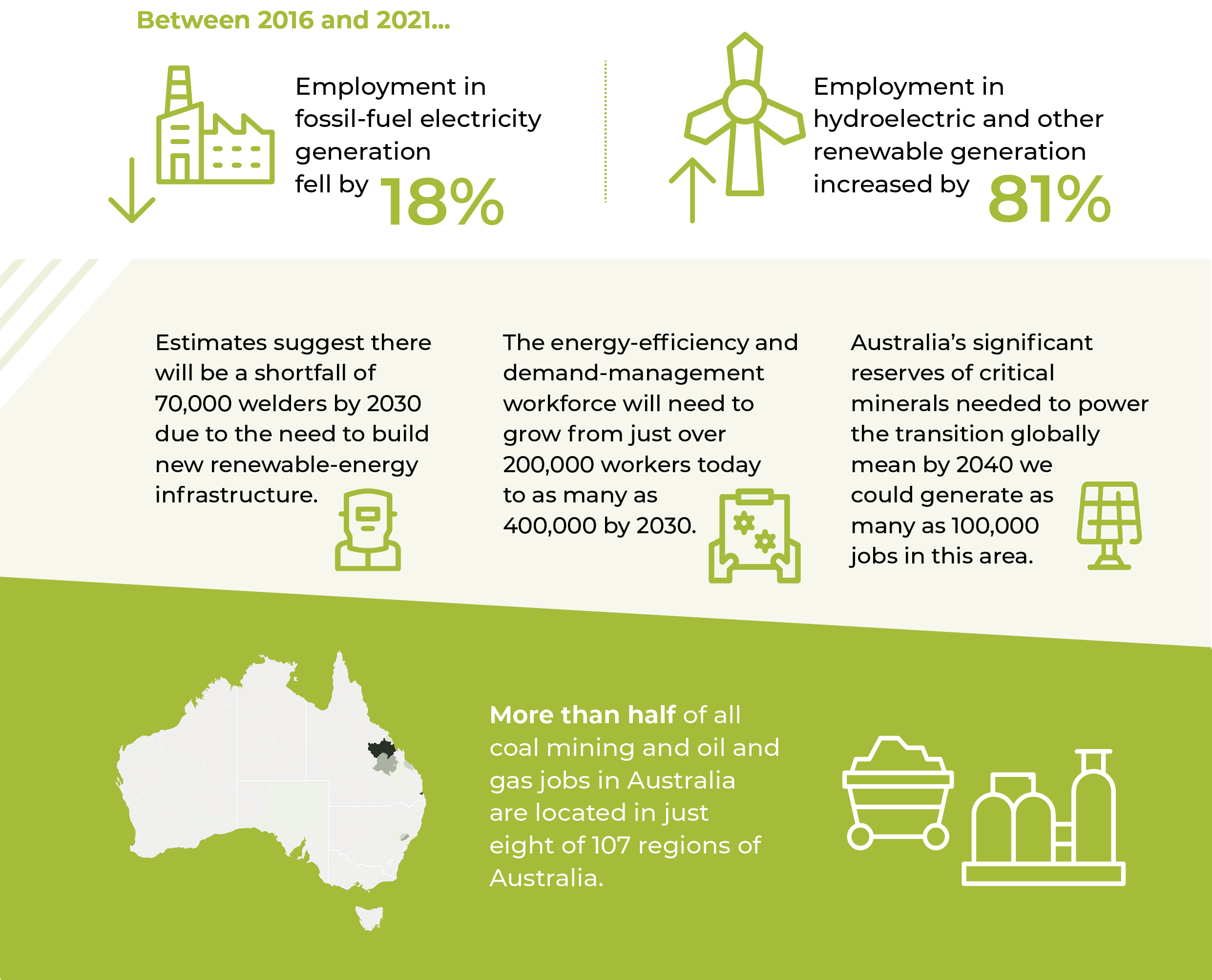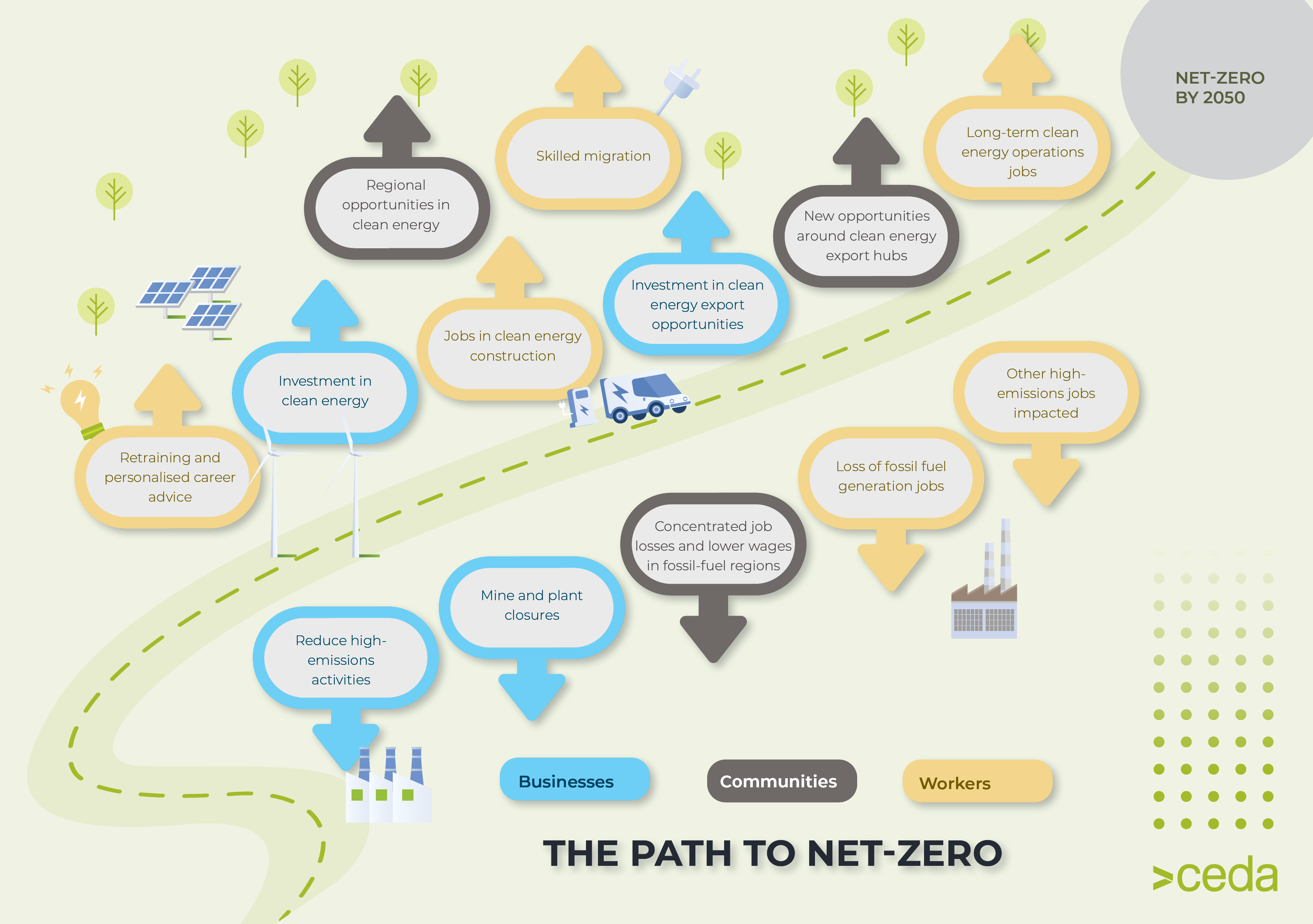Explore our Climate and Energy Hub
Australia’s commitment to cut greenhouse-gas emissions by 43 per cent from 2005 levels by 2030 and reach net-zero emissions by 2050 will require significant change to the way energy is generated and used, and have wide-ranging implications for the skills and people needed in the labour market. There will be direct effects on those working in energy, but also for energy-using sectors such as buildings/construction, transport and agriculture.
Modelling suggests the energy transition will change the nature of jobs across a broad range of sectors, without having a big impact on the total number of jobs.
There will be opportunities for high quality work in renewables, electricity networks and energy performance across utilities, agriculture, mining and transport.
But those with low or medium skill levels in fossil-fuel industries will likely struggle to find jobs with similar wages, as a greater share of clean-energy roles require post-secondary education. Certain regions are also more exposed, as clean-energy jobs are likely to be more geographically dispersed than coal mining and power stations.

The level of disruption to workers in traditional energy jobs will be determined by how easily they can transfer their skills. This will vary considerably across roles. Our analysis finds that energy industries such as fossil-fuel generation and renewables require relatively similar skills on average, but it will be easier for high-skilled workers such as engineers to retrain than those in highly specialised roles such as power-plant operators.
Displaced employees with strong foundational skills (literacy, numeracy, communication and digital skills) will be best placed to retrain, ideally for jobs that use similar skills to their previous roles. Pervasive skill shortages in clean energy could delay the transition, making it doubly important to enable reskilling. Not all traditional energy employees will transition directly to clean-energy roles, however, as their skills will also be valued in other industries such as mining or construction.

Job mobility in Australia has declined over several decades and is low by international comparison. Removing barriers to changing jobs is thus critical. Governments must act immediately to remove regulatory barriers to developing new skills and training courses adapted to industry needs and the specific safety risks of new technologies. State-based occupational licensing needs to be updated, streamlined and nationally harmonised.
Immigration can help to fill skill shortages in clean energy and transfer expertise to local workers. Fast, simple pathways for highly skilled temporary workers should urgently be implemented. Governments must also improve the consistency of skills recognition. The separate processes to access a labour migration visa and satisfy occupational licensing are complex and burdensome.
Support for the most affected communities should prioritise assisting workers and communities rather than subsidies for businesses. Governments should avoid long-term income support, as this reduces incentives for diversification, and financial compensation for owners closing high-emissions facilities.
The Federal Government’s May 2023 announcement that it will establish a new Net Zero Authority should help to smooth the transition for affected workers and communities. With clearly defined objectives and a more targeted function than initially proposed, the authority should complement and enable local initiatives by:
- Ensuring access to personalised support and career planning for all affected workers, concentrated on those with the greatest need;
- Coordinating across different levels of government, industry, unions and education and training providers to ensure new training meets demand;
- Investing in local initiatives to catalyse new job opportunities through economic diversification in the most severely affected communities; and
- Using data to evaluate and reprioritise transition policy.
Australia’s low job mobility and mixed success during past structural adjustments, such as the end of car manufacturing, mean we must act now to enable as many people as possible to take advantage of new opportunities.
Recommendation 1
Support for workers and communities
Governments should support workers and communities rather than businesses, and avoid policies that reduce incentives to move jobs and retrain, such as job guarantees.
Recommendation 2
Nationally harmonise occupational licences
State and Federal governments must take immediate action to update, streamline and nationally harmonise relevant occupational licences to reduce barriers to labour mobility where this will not jeopardise safety. Licensing should enable modern training pathways in new technologies such as small-scale renewables and electric vehicles.
Recommendation 3
Clear objectives for Net Zero Authority
The new Net Zero Authority must have clear objectives to focus on the structural adjustment challenge in the most affected communities. Ensure all adversely affected workers receive personalised support and career planning; Coordinate across different levels of government, industry, unions and education and training providers to improve clarity around clean-energy skills and retraining pathways, and enable new courses to keep up with demand; Invest in locally-driven projects to create new jobs through economic diversification in the most severely affected communities; and Use data to evaluate and reprioritise transition policy.
Recommendation 4
Streamline temporary skilled migration
The Federal Government should streamline temporary skilled migration to enable fast, simple pathways for highly skilled clean-energy workers, including via intra-company transfers.
Recommendation 5
Communicate the transition challenge
Governments must do more to communicate the transition challenge through forward-looking policies to cut emissions, detailed jobs-market modelling and clearly outlining what the transition will look like in the most affected communities.
The map shows the number of fossil-fuel related jobs (coal mining, oil and gas, and fossil fuel power generation) by local government area. Other factors will affect the exposure of regions to the energy transition. For example, a region with a concentration of coal-fired power generation is likely to face an earlier transition than a region that exports metallurgical coal used for steel making, which is likely to remain in demand globally for longer.


.png)